

Our counselors are available to you 24/7 to answer any questions you have and help you find the the treatment program that fits your needs.
All calls completely confidential.
1-866-586-2277Individuals who have given up trying to get help for a drug or alcohol problem in California may just need better answers. Not every drug treatment program is going to provide the best results for all clients, and there are programs which are more effective than others with higher success rates at treating those who have more extensive addictions issues. So when failures happen, it is often times because the person just wasn't given the very best chance to begin with. When a proper assessment is done by treatment professionals and the most highly recommended drug rehab on an individual basis is accessible the best results can be achieved. So speak with a drug treatment counselor in California to find out what the best option for your or someone you care about is today.
In a single-day count in 2013, 117,159 individuals were enrolled in some type of substance use treatment in California. Among individuals in California enrolled in substance use treatment that year, nearly 42% were in treatment for drug use only, nearly 17% were in treatment for alcohol use only, and nearly 42% were in treatment for both drug and alcohol use. When looking into which illicit drugs were significant problems among treatment admissions in the state, amphetamines and heroin stand out. Amphetamines are a category of drug that would include the highly addictive street drugs methamphetamine, crystal meth, and the like. When you include �''other opiates�'', which would be prescription pain killers, opiates in general and amphetamines are abused at the exact same rates among treatment admissions. Both addictions, amphetamine and opiate, are extremely troublesome and difficult to overcome in even the very best circumstances with very high relapse rates. So California drug treatment programs have their work cut out for them.
Nearly 950,000 California residents aged 12 and older report that they are dependent on or abuse alcohol, a rate that has not changed significantly over the past several years. Sadly, only 8% of these individuals received treatment for this problem last year. The number of individuals receiving help for both and alcohol abuse in the state has been steadily declining in fact, so the problem is getting worse not better. One of the problems with alcohol treatment in California is the idea that there is only one approach that is going to work. Just because traditional treatment models have been around for a long time and are well-accepted in California, such as 12-step, doesn't mean they have the highest success rates. 12-step programs in general and AA actually have very low rates of success for example, a mere 10% at best in many cases. Alcohol treatment in California must be aggressive enough to match the aggressiveness of the problem, and the highest success rates can be seen in programs which provide an integrated approach to treatment and the most appropriate environment to suit their client's level of dependence.
There are around 1550 drug treatment programs in the state of California, over 1,100 of which are outpatient treatment programs. Nearly 1,000 of the outpatient programs in the state deliver the very minimal amount of treatment that could be delivered in such circumstances, and provide counseling and therapy to clients anywhere from 1 day a week to every day depending on what type of program the client is involved in. Intensive outpatient is usually more intensive than regular outpatient services, and some facilities deliver both. There are also over 250 facilities in California which provide day treatment/partial hospitalization, which is an everyday commitment for most and also makes additional services available to them which wouldn't be available in another outpatient setting, such as dual diagnosis treatment for individuals with a co-occurring mental health disorder.
It should come as no surprise, due to the apparent opiate addiction which is at epidemic proportions in the state, that there are at least 150 outpatient programs in the state providing opiate maintenance services. These facilities administer prescription drugs such as methadone and buprenorphine to clients who are opiate dependent, and there are nearly 29,000 outpatient clients participating in opiate maintenance services in California at this time. Opiate maintenance services are very different from traditional treatment services, because individuals won't typically be taking part in other treatment aside from receiving the medicine that they are given daily to stop their drug seeking behavior. It is only effective in curbing cravings and stopping harsh withdrawal syndrome, it doesn't effectively cure opiate dependence.
However, there are 46 hospital inpatient facilities in the state and there are also around 560 residential non-hospital programs which deliver either short-term 30-day treatment or long term treatment for more serious cases. The most obvious difference between outpatient and these options is the individual will remain in the inpatient or residential facility, which is drug and alcohol free, which in itself eliminates the risk of relapse while undergoing treatment. It also provides an environment which is more conducive to effective treatment, because individuals don't have anything distracting them from their treatment whether it is work and family obligations or perhaps drug using influences. So needless to say, these programs generally speaking have far higher success rates than outpatient programs in California, particularly those which provide the most comprehensive and extensive treatment plans.
There are anywhere from 15-16,000 treatment clients participating in hospital inpatient and residential non-hospital drug rehab facilities in California each year. This is in stark contrast to the numbers for outpatient programs which handle over 100,000 clients annually. Inpatient and residential treatment requires more of a commitment which can make it difficult for some clients who have obligations they genuinely cannot take a break from to receive treatment. But for most, taking a break from their normal everyday life is exactly what will help them truly overcome their drug or alcohol addiction. In a short term inpatient or residential program in California, clients can expect to become involved in a treatment process that obligates them to participate in either a short term 30-day program or a long term treatment plan of 60 days or more. program. Many years or research and studies of long term outcomes have proven that success rates for treatment clients are directly commensurate to the time and effort they put into it. Some programs are more vigorous than others, and some have a more effective approach but don't take as long. If someone speaks with a treatment counselor to determine which inpatient or residential program is right for them, they can find the right match.
How much is involved in outpatient treatment in California really all depends on which program you are participating in. If the outpatient program primarily focuses treatment around meetings, group counseling, focus groups, etc. then you can anticipate slower results than a program where you are more involved in activities tailored for you and your circumstances in particular. There are outpatient treatment programs in California which offer more individualized treatment, and other services which are more personalized to you such a behavioral modification and motivational therapy. Outpatient treatment is again a very minimalistic approach, and is not aggressive enough in most cases when someone has struggled with a chronic drug or alcohol problem and who hasn't responded well to outpatient treatment in the past. For example, someone who has taken part in outpatient treatment before but relapsed won't typically do any better the second or third time, and an inpatient or residential treatment program would be far more ideal.
1733 Euclid Avenue
San Diego, CA. 92105
600 A Street
Davis, CA. 95616
350 Hillmont Avenue
Ventura, CA. 93003
950 North State Street
Hemet, CA. 92543
520 North La Brea Avenue
Inglewood, CA. 90302
950 West Julian Street
San Jose, CA. 95126
3230 Warning Court
Oceanside, CA. 92056
1730 West Olympic Boulevard
Los Angeles, CA. 90015
515 North Palm Canyon Drive
Palm Springs, CA. 92262
215 West Madison Avenue
El Cajon, CA. 92020
11523 C Avenue
Auburn, CA. 95603
14433 Emelita Street
Van Nuys, CA. 91401
2415 University Avenue
Palo Alto, CA. 94303
2211 and 2137 East Ocean Boulevard
Long Beach, CA. 90803
200 Vera Canyon Road
Malibu, CA. 90265
2045 Fairmont Drive
San Leandro, CA. 94578
1227 East Los Angeles Avenue
Simi Valley, CA. 93065
17216 Slover Avenue
Fontana, CA. 92337
1722 South Lewis Road
Camarillo, CA. 93012
1400 Emeline Avenue
Santa Cruz, CA. 95060
251 Georgia Street
Vallejo, CA. 94590
1050 North Garey Avenue
Pomona, CA. 91767
5482 Business Drive
Huntington Beach, CA. 92649
120 West School Avenue
Visalia, CA. 93291
1909 16th Street
Bakersfield, CA. 93301
1441 Constitution Boulevard
Salinas, CA. 93906
21810 Normandie Avenue
Torrance, CA. 90502
215 North D Street
Porterville, CA. 93257
1412 East Chapman Avenue
Orange, CA. 92866
162 Grove Street
Bishop, CA. 93514
251 Llewellyn Avenue
Campbell, CA. 95008
4440 Calle Real
Santa Barbara, CA. 93110
21054 Sherman Way
Canoga Park, CA. 91303
1411 North Grand Avenue
Covina, CA. 91724
1488 East Lincoln Avenue
Anaheim, CA. 92805
5985 Topanga Canyon Boulevard
Woodland Hills, CA. 91367
230 Golden Gate Avenue
San Francisco, CA. 94102
2750 Sutterville Road
Sacramento, CA. 95820
1688 North Perris Boulevard
Perris, CA. 92571
3323 Marengo Avenue
Altadena, CA. 91001
15229 East Amar Road
La Puente, CA. 91744
23625 Holman Highway
Monterey, CA. 93940
2501 West El Segundo Boulevard
Hawthorne, CA. 90250
1911 Williams Drive
Oxnard, CA. 93036
17631 Chatsworth Street
Granada Hills, CA. 91344
1341 North Escondido Boulevard
Escondido, CA. 92026
- - -
Loomis, CA. 95650
341 South Hillcrest Street
La Habra, CA. 90631
939 North D Street
San Bernardino, CA. 92410
7171 North Cedar Avenue
Fresno, CA. 93720
26081 Mocine Avenue
Hayward, CA. 94544
4020 Palos Verdes Drive North
Palos Verdes Peninsula, CA. 90274
14659 Olive Drive
Sylmar, CA. 91342
5230 North Clark Avenue
Lakewood, CA. 90712
680 West Main Street
El Centro, CA. 92243
500 North 9th Street
Modesto, CA. 95350
26137 La Paz Road
Mission Viejo, CA. 92691
24242 La Cresta Drive
Dana Point, CA. 92629
11201 Benton Street
Loma Linda, CA. 92357
751 West Orangethorpe Avenue
Fullerton, CA. 92832
1450 North Lake Avenue
Pasadena, CA. 91104
956 East Tabor Avenue
Fairfield, CA. 94533
525 21st Street
Oakland, CA. 94612
1433 East Route 66
Glendora, CA. 91740
2101 East 1st Street
Santa Ana, CA. 92705
838 Beach Court Road
Coloma, CA. 95613
1131 San Felipe Road
Hollister, CA. 95023
10155 Colima Road
Whittier, CA. 90603
8207 Whittier Boulevard
Pico Rivera, CA. 90660
207 37th Street
Richmond, CA. 94805
1300 West Lodi Avenue
Lodi, CA. 95242
12350 Indian River Drive
Apple Valley, CA. 92308
315 G Street
Antioch, CA. 94509
10425 South Painter Avenue
Santa Fe Springs, CA. 90670
891 Mountain Ranch Road
San Andreas, CA. 95249
67580 Jones Road
Cathedral City, CA. 92234
2607 Willo Lane
Costa Mesa, CA. 92627
2449 Pacheco Street
Concord, CA. 94520
2145 5th Avenue
Oroville, CA. 95965
18912 Patrician Drive
Villa Park, CA. 92861
6666 Owens Drive
Pleasanton, CA. 94588
631 West F Street
Oakdale, CA. 95361
7000 South Center Drive
Clearlake, CA. 95422
415 West Foothill Boulevard
Claremont, CA. 91711
2260 Watson Way
Vista, CA. 92083
11429 Valley Boulevard
El Monte, CA. 91731
1515 West Cameron Avenue
West Covina, CA. 91790
47915 Oasis Street
Indio, CA. 92201
6181 Mission Street
Daly City, CA. 94014
49774 Road 426
Oakhurst, CA. 93644
11060 Magnolia Avenue
Riverside, CA. 92505
180 East Leland Road
Pittsburg, CA. 94565
15450 and 15430 County Road 99
Woodland, CA. 95695
19900 Plummer Street
Chatsworth, CA. 91311
44443 10th Street West
Lancaster, CA. 93534
27122A Paseo Espada
San Juan Capistrano, CA. 92675
607 Donna Way
San Jacinto, CA. 92583
2335 Mountain Avenue
Duarte, CA. 91010
768 Pleasant Valley Road
Diamond Springs, CA. 95619
474 South Citrus Avenue
Azusa, CA. 91702
11401 South Bloomfield Avenue
Norwalk, CA. 90650
835 3rd Avenue
Chula Vista, CA. 91911
333 Laws Avenue
Ukiah, CA. 95482
625 Fair Oaks Avenue
South Pasadena, CA. 91030
8210 South Bright Road
French Camp, CA. 95231
4741 Engle Road
Carmichael, CA. 95608
2940 Inland Empire Boulevard
Ontario, CA. 91764
5 Mareblu
Aliso Viejo, CA. 92656
262 Gaffey Road
Watsonville, CA. 95076
828 High Street
Delano, CA. 93215
222 West Sixth Street
San Pedro, CA. 90731
1546 1st Street
Napa, CA. 94559
604 West Ocean Avenue
Lompoc, CA. 93436
145 Hodencamp Road
Thousand Oaks, CA. 91360
290 IOOF Avenue
Gilroy, CA. 95020
6301 Beach Boulevard
Buena Park, CA. 90621
1960 Church Avenue
San Martin, CA. 95046
38215 San Francisquito Cyn Road
Santa Clarita, CA. 91350
20094 Mission Boulevard
Castro Valley, CA. 94546
2721 Barbera Way
Rancho Cordova, CA. 95670
12821 Victory Boulevard
North Hollywood, CA. 91606
105 Hospital Road
Sonora, CA. 95370
2060 Campus Drive
Yreka, CA. 96097
251 Jackson Avenue
Redwood City, CA. 94061
401 West Morrison Avenue
Santa Maria, CA. 93458
299 12th Street
Marina, CA. 93933
11705 Deputy Yamamoto Place
Lynwood, CA. 90262
647 Camino de los Mares
San Clemente, CA. 92673
39000 Bob Hope Drive
Rancho Mirage, CA. 92270
30500 Arrastre Canyon Road
Acton, CA. 93510
795 Willow Road
Menlo Park, CA. 94025
41945 Big Bear Boulevard
Big Bear Lake, CA. 92315
10 Woodland Road
St. Helena, CA. 94574
2640 Martin Luther King Jr Way
Berkeley, CA. 94704
24352 Featherstone Canyon Road
Lakeside, CA. 92040
704 Mill Street
Loyalton, CA. 96118
154 Tule Creek Road
Hayfork, CA. 96041
8835 Vans Street
Paramount, CA. 90723
3250 Guerneville
Santa Rosa, CA. 95401
251 Lafayette Circle
Lafayette, CA. 94549
150 Muir Road
Martinez, CA. 94553
535 Cesar Chavez Boulevard
Calexico, CA. 92231
717 Lincoln Boulevard
Venice, CA. 90291
1125 North Hunter Street
Stockton, CA. 95202
2370 Buhne Street
Eureka, CA. 95501
16248 Victor Street
Victorville, CA. 92395
1350 Third Street
La Verne, CA. 91750
1322 North Avalon Boulevard
Wilmington, CA. 90744
1288 Morro Street
San Luis Obispo, CA. 93401
1050 North Cherry Street
Tulare, CA. 93274
24300 El Toro Road
Laguna Woods, CA. 92637
11980 Mount Vernon Avenue
Grand Terrace, CA. 92313
66735 Martinez Road
Thermal, CA. 92274
1529 East Palmdale Boulevard
Palmdale, CA. 93550
307 Placentia Avenue
Newport Beach, CA. 92663
628 South 8th Street
Banning, CA. 92220
270 County Hospital Road
Quincy, CA. 95971
23232 Peralta Drive
Laguna Hills, CA. 92653
7101 Baird Avenue
Reseda, CA. 91335
13931 Van Ness Avenue
Gardena, CA. 90249
1965 Live Oak Boulevard
Yuba City, CA. 95991
55 Shaver Street
San Rafael, CA. 94901
16237 Ventura Boulevard
Encino, CA. 91436
30101 Agoura Court
Agoura Hills, CA. 91301
14511 Carfax Street
Tustin, CA. 92780
2400 Washington Avenue
Redding, CA. 96001
8946 Madison Avenue
Fair Oaks, CA. 95628
8739 Santa Monica Boulevard
West Hollywood, CA. 90069
1486 Huntington Avenue
South San Francisco, CA. 94080
500 Crown Point Circle
Grass Valley, CA. 95945
40165 Murrieta Hot Springs
Murrieta, CA. 92563
5820 Chestnut Avenue
Orangevale, CA. 95662
11643 Glenoaks Boulevard
Pacoima, CA. 91331
420 East Cotati Avenue
Cotati, CA. 94931
4619 North Rosemead Boulevard
Rosemead, CA. 91770
11207 Valley Ford Road
Petaluma, CA. 94952
14305 East Morgan Street
Baldwin Park, CA. 91706
10877 Conductor Boulevard
Sutter Creek, CA. 95685
5615 Hessel Avenue
Sebastopol, CA. 95472
24460 Lyons Avenue
Newhall, CA. 91321
101 South Kraemer Boulevard
Placentia, CA. 92870
2150 Cold Canyon Road
Calabasas, CA. 91302
2 Hughes Street
Irvine, CA. 92616
1500 East Kay Street
Compton, CA. 90221
7339 El Cajon Boulevard
La Mesa, CA. 91942
1187 East South Street
Orland, CA. 95963
500 B Jefferson Boulevard
West Sacramento, CA. 95605
2 9th Street
Marysville, CA. 95901
23119 Cottonwood Avenue
Moreno Valley, CA. 92553
3250 Country Rose Circle
Encinitas, CA. 92024
6302 13th Avenue
Lucerne, CA. 95458
1904 Richland Avenue
Ceres, CA. 95307
601 H Street
Brawley, CA. 92227
6330 Thornton Avenue
Newark, CA. 94560
612 Spring Road
Moorpark, CA. 93021
1419 Jensen Avenue
Sanger, CA. 93657
5445 Laurel Canyon Boulevard
Valley Village, CA. 91607
730 Magnolia Avenue
Corona, CA. 92879
4388 Katella Avenue
Los Alamitos, CA. 90720
3111 Winona Avenue
Burbank, CA. 91504
5362 Lemee Lane
Mariposa, CA. 95338
1297 West Hobsonway
Blythe, CA. 92225
1540 East Colorado Street
Glendale, CA. 91205
750 Spaans Drive
Galt, CA. 95632
460 East Carson Plaza Drive
Carson, CA. 90745
3612 Madison Avenue
North Highlands, CA. 95660
5712 Camp Street
Cypress, CA. 90630
222 West 39th Avenue
San Mateo, CA. 94403
209 East 7th Street
Madera, CA. 93638
2930 Camino Diablo
Walnut Creek, CA. 94597
14320 Palm Drive
Desert Hot Springs, CA. 92240
1076 Santo Antonio Street
Colton, CA. 92324
845 West East Avenue
Chico, CA. 95926
2049 Skyline Drive
Lemon Grove, CA. 91945
20851 Cheney Drive
Topanga, CA. 90290
590 West El Camino Street
Mountain View, CA. 94040
2524 La Costa Avenue
Carlsbad, CA. 92009
2110 Ferry Street
Anderson, CA. 96007
8491 North Lake Boulevard
Kings Beach, CA. 96143
1860 Walnut Street
Red Bluff, CA. 96080
9401 Crystal Creek Road
Lucerne Valley, CA. 92356
242 North Villa Avenue
Willows, CA. 95988
113 East F Street
Tehachapi, CA. 93561
3666 Valley View Avenue
Norco, CA. 92860
11500 Paramount Boulevard
Downey, CA. 90241
100 Park Place
San Ramon, CA. 94583
1255 B Street
Merced, CA. 95341
890 Lake Sherwood Drive
Westlake Village, CA. 91361
499 Loma Alta Avenue
Los Gatos, CA. 95030
333 Sunrise Avenue
Roseville, CA. 95661
11777 Sebastian Way
Rancho Cucamonga, CA. 91730
145 Bost Avenue
Nevada City, CA. 95959
1777 Buckman Springs Road
Campo, CA. 91906
1912 Central Avenue
Alameda, CA. 94501
559 Mendocino Court
Atwater, CA. 95301
6538 Grey Oak Court
Citrus Heights, CA. 95621
3551 Whipple Road
Union City, CA. 94587
19000 East Homestead Road
Cupertino, CA. 95014
334 Shaw Avenue
Clovis, CA. 93612
1841 East Main Street
Barstow, CA. 92311
1111 East Stanley Boulevard
Livermore, CA. 94550
19642 Ballinger Street
Northridge, CA. 91324
5607 Mount Murphy Road
Garden Valley, CA. 95633
104720 Old Catholic Church Road
Clearlake Oaks, CA. 95423
1647 West Anaheim Street
Harbor City, CA. 90710
1050 Los Vallecitos Boulevard
San Marcos, CA. 92069
1400 North Norma Street
Ridgecrest, CA. 93555
215 South 4th Street
Chowchilla, CA. 93610
371 Bowline Drive
Vacaville, CA. 95687
145 Tamal Road
Forest Knolls, CA. 94933
605 South Myrtle Avenue
Monrovia, CA. 91016
1471 B Street
Livingston, CA. 95334
255 South Cabrillo Highway
Half Moon Bay, CA. 94019
1523 Longbranch Street
Grover Beach, CA. 93433
300 H Street
Needles, CA. 92363
727 Cedar Street
Garberville, CA. 95542
12627 Santa Gertrudes Avenue
La Mirada, CA. 90638
10751 Dale Street
Stanton, CA. 90680
34248 Via Santa Rosa
Capistrano Beach, CA. 92624
14750 El Camino Real
Del Mar, CA. 92014
21505 Norwalk Boulevard
Hawaiian Gardens, CA. 90716
468 Pine Avenue
Pacific Grove, CA. 93950
16111 Plummer Street
North Hills, CA. 91343
1260 East Arrow Highway
Upland, CA. 91786
550 Patterson Boulevard
Pleasant Hill, CA. 94523
525 Grand Avenue
Spring Valley, CA. 91977
6765 Green Valley Road
Placerville, CA. 95667
8950 Villa La Jolla Drive
La Jolla, CA. 92037
61607 29 Palms Highway
Joshua Tree, CA. 92252
1152 Sonoma Avenue
Seaside, CA. 93955
1900 Lake Tahoe Boulevard
South Lake Tahoe, CA. 96150
34401 and 34413 Blackstone Way
Fremont, CA. 94555
10015 Palisades Drive
Truckee, CA. 96161
14140 Beach Boulevard
Westminster, CA. 92683
1231 Northcrest Drive
Crescent City, CA. 95531
45 Hazel Road
Willits, CA. 95490
10420 Main Street
Lamont, CA. 93241
8134 Van Nuys Boulevard
Panorama City, CA. 91402
23492 White Dove Street
Lake Forest, CA. 92630
20830 Parthenia Street
Winnetka, CA. 91306
2523 El Portal Drive
San Pablo, CA. 94806
40925 County Center Drive
Temecula, CA. 92590
31872 Coast Highway
Laguna Beach, CA. 92651
16940 State Highway 14
Mojave, CA. 93501
40 West G Street
Los Banos, CA. 93635
101 Sand Creek Road
Brentwood, CA. 94513
19325 Cherokee Road
Tuolumne, CA. 95379
10031 Lampson Avenue
Garden Grove, CA. 92840
16170 Main Street
Lower Lake, CA. 95457
12370 Clay Station Road
Herald, CA. 95638
925 Brockhurst Street
Emeryville, CA. 94608
700 North Irwin Street
Hanford, CA. 93230
3076 Myrtledale Road
Calistoga, CA. 94515
20640 3rd Street
Saratoga, CA. 95070
17165 Newhope Street
Fountain Valley, CA. 92708
36977 Park Avenue
Burney, CA. 96013
3556 El Camino Real
Atascadero, CA. 93422
18780 Amar Road
Walnut, CA. 91789
1424 4th Street
Santa Monica, CA. 90401
600 3rd Street
Lake Elsinore, CA. 92530
660 South Fair Oaks Avenue
Sunnyvale, CA. 94086
790 South Franklin Street
Fort Bragg, CA. 95437
957 Industrial Road
San Carlos, CA. 94070
3192 Glen Canyon Road
Scotts Valley, CA. 95066
23501 Cinema Drive
Valencia, CA. 91355
16390 Main Street
Guerneville, CA. 95446
1450 Main Street
Weaverville, CA. 96093
162 East Carson Street
Colusa, CA. 95932
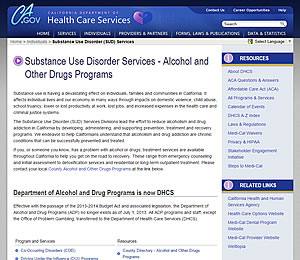
California Department of Health Care Services (DHCS) provides Californians with access to affordable, high-quality health care, including medical, dental, mental health, substance use disorder services, and long-term services and supports.
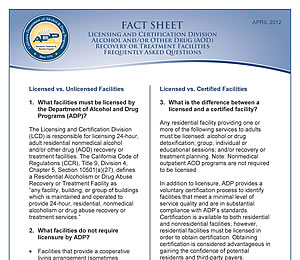
Frequently asked questions about Licensed vs. Certified vs. Unlicensed alcohol and/or other Drug Recovery or Treatment Facilities.
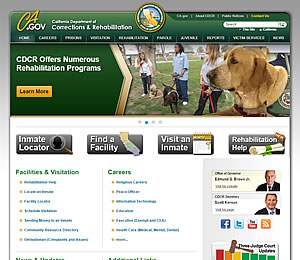
California Department of Corrections & Rehabilitation offers numerous rehabilitative programs and services provided to both prison inmates and parolees. This website also offers an Inmate Locator and Facility Locator.
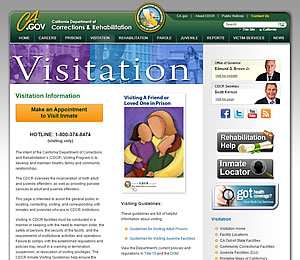
CDCR inmate visitation page is intended to assist the general public in locating, contacting, visiting, and corresponding with inmates and juveniles who are in CDCR institutions.

The California Governor's Safe & Drug-Free Schools & Communities Project works to promote alcohol, drug, and violence prevention in Schools and communities.
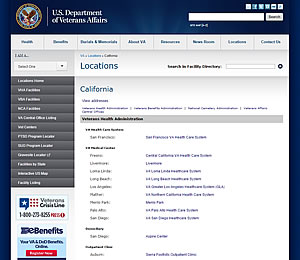
US Department of Veterans Affairs (VA) California Locations for VA Central Offices, Medical Centers, and Outpatient Clinics.